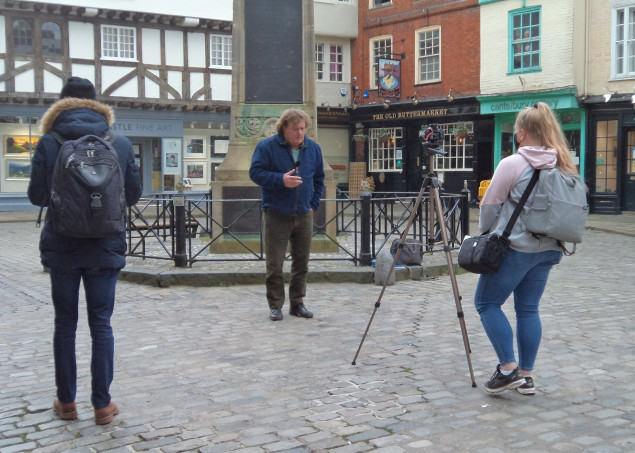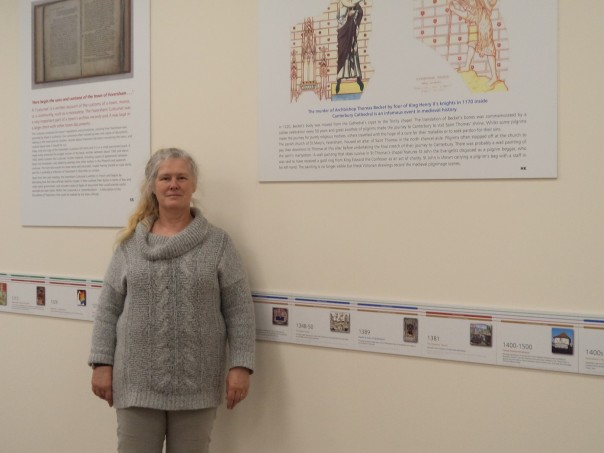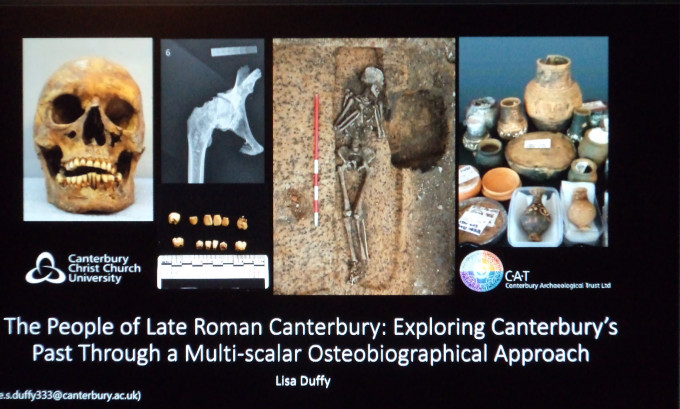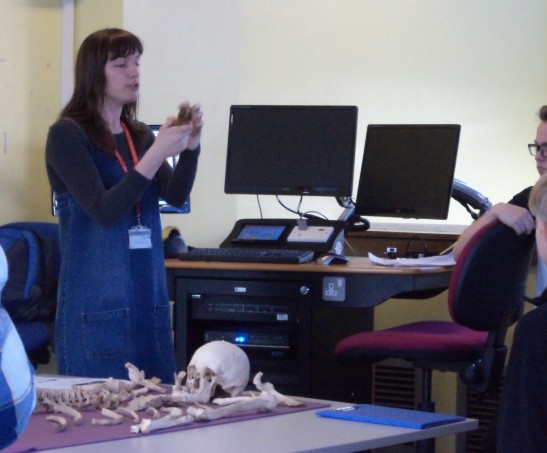I thought I would begin with some great news. Dean Irwin is now Dr Dean Irwin. Very many congratulations Dean, that is brilliant for medieval Jewish studies. Secondly, although Janet Clayton is not yet back home, she is making good progress recovering from her fall at Scadbury. All the Kent History Postgraduates again send their very best wishes, as do those from the Centre – we hope you are able to return home soon and make a full recovery!
Before I get to Lisa Duffy’s fascinating presentation, I thought I would just mention a couple of things. Firstly, due to Dr Claire Bartram’s intervention as Co-Director of the Centre, Tudors and Stuarts 2021 featured in CCCU’s Staff Newsletter In Touch this week. Also, we now have the final accounts and the online History Weekend had added just under £2000 to the Ian Coulson Postgraduate Award fund. This represents slightly less than 40% of the sum added by Tudors and Stuarts 2019, but, of course, this time ticket prices were lower and were per device not per person, and we had an especially generous deal for schools. This was enjoyed by at least four schools – from Canterbury to Cambridge.

Secondly, as members of the Magna Carta Advisory Group, Dr Diane Heath and I will be joining representatives from Faversham Town Council, local heritage groups, Kent Archives and Dr Justin Croft, an expert on medieval custumals, to offer advice and support regarding the Town Council’s exciting new Magna Carta Exhibition that will be established at 12 Market Place in the centre of the town.
Thirdly, and keeping with the collaborative and advisory theme, last Saturday I led a Kent Local History Societies Forum as a joint initiative under Kent Archaeological Society and the Centre. The inaugural meeting should have taken place last spring but had to be cancelled and the recent online meeting brought together fourteen society representatives, with more societies wanting to take part next time. It was a very useful meeting, and most interesting to hear how the different groups have responded to the challenges of the last year. These developments included the great growth in the use of Zoom, the centrality of society websites, how some have branched out onto other social media platforms, and the desire among some group members to find alternative means of conducting research during the closure of local studies centres and archives. If you are interested to find out more, Fred Birkbeck, the KAS Brand Manager is preparing a KAS Bulletin from my report which, I believe, will be going to members and then will be on the Society’s website.

A good number of the Kent History Postgraduates group met this week to see Lisa’s presentation on her doctoral project using three Roman cemeteries just outside the city wall. Lisa had used one of these for her MA, and to Hallet’s Garage site she has now added the Peugeot garage site and the Rhodus Town site nearby. As she said, this is an opportune moment because since 2009 the number of Roman inhumations from Canterbury available for study has expanded tremendously and even though not all are sufficiently well preserved for extensive analysis, in total there are over 300 such burials discovered from these three sites. Furthermore, Lisa is part of a burgeoning group of archaeologists working on Canterbury’s Roman cemeteries, and Dr Jake Weekes from Canterbury Archaeological Trust is very heavily involved. In addition, scientific techniques and their use has become far more prevalent in recent years, meaning that DNA and isotopic analysis has almost become standard practice.
Timing is equally good because new theoretical approaches are being developed in the area of osteobiography, a term coined by Frank Saul in 1972, and Lisa’s study will be the first synthetic analysis of the bioarchaeology of Roman Canterbury. Consequently, by bringing together the biological, environmental and cultural factors which affected people, as seen in their skeletal remains, she is seeking to explore what life was like for ordinary people in the city and surrounding areas during this period. Furthermore, the use of this approach to investigate life narratives for a considerable number of individuals through their bones will allow Lisa to bridge the gap between the individual and the population. For by pulling together lots of these biocultural stories from her skeletons, she will be able to ask questions about life course to offer a more nuanced approach, looking at topics such as identity, the experiences of marginal groups, the incidence of migration, all of which will offer ways to complement, as well as challenge historical narratives about Roman Britain.

Lisa then took her audience on a tour of the three sites. Hallet’s Garage was a rescue excavation that began in 2009 and where 120 inhumations were found. This large population comprised a good mix of men, women and children and interestingly they were organized in rows suggesting that this was a well-managed cemetery. Even though a large amount of post-excavation work has been carried out, to a degree this has been hampered by the need for speed during the excavation itself. This meant not all the information needed was recorded, but it still remains a valuable dataset for Lisa’s analysis.
Moving to the south side of Canterbury, the excavation at Rhodus Town took place in 2013, producing 20 inhumation graves. However, the site did yield a rich array of grave goods and the grave cuts were exceptionally and highly unusually very deep. It has been postulated that they represent a discrete family cemetery and there is also evidence of a ‘laying out’ funerary phase, involving rituals before the burial itself.
Adjacent to Rhodus Town is the Peugeot garage site that was excavated in 2015 and yielded 219 inhumation graves. Again there were grave goods, but they were fewer than at Rhodus Town. Interestingly, there were two decapitation burials, and one burial with a cist made from tiles, with another from possibly the 5th century, which points to a degree of continuity.
Drawing this together, Lisa then discussed how she is going to use her findings from the 175 well preserved individuals across the three sites. Using the theoretical ideas outlined above, she is going to adopt a series of themed narratives. These are ‘growing up and growing old’; ‘occupational/activity stress’; ‘suffering and care’, and ‘death and society’.

To give the group an idea of the findings she will be working on, Lisa mentioned some of her preliminary discoveries regarding diet, the significance of familial groups, the incidence of what we might think of as modern diseases, and the proportion who had been born and had died in Canterbury. I’ll just mention a few examples here because Lisa is going to give the group another presentation when she has completed more of her analysis.
Thinking about the young and the old, Lisa said that Roman society did not treat those under one as having any real status at all, and to a degree this seems to have extended to the first few years of life in that the skeletons showed signs of nutritional stress, with a degree of differentiation according to their socioeconomic status. Regarding diet more broadly, her subjects appeared to have lived on a typical diet of the period, with evidence of imported food, an indicator of trade, and the importance of marine foodstuffs.
In terms of occupations or activity, arthritis was present and occupational stresses varied between the sexes, men showing evidence of this in the lower body, including the ankles, whereas for women it was most noticeable in the upper body. Such finding would seem consistent with the likely work patterns of men compared to women, In addition, it seemed that for those who had suffered chronic injuries, this did not stop them from working in most cases.
Regarding suffering and care, such chronic injuries were an important feature of life, but so were healed fractures, suggesting that there was at least some medical care available. Disease also leaves traces, and among the conditions seen are gall stones and possibly evidence relating to cancer. Moreover, when coming to death and behaviour concerning pre-burial rites, Lisa is finding evidence of shared practices that may relate to familial experiences.
Following Lisa’s presentation members of the group were keen to ask a wide range of questions and many of these queries related to her primary findings. There was also a general feeling that her research methods were going to open up the study of skeletons and that her innovative methods were great, especially when studying members of the general populace. Thus ended another very successful presentation and next time we shall have a general catch up.

Looking at next week, Diane will be at the Royal Harbour Academy in Ramsgate leading a ‘Peasants’ Revolt’ workshop to Year 7s and an ‘Elizabethan’ workshop to Year 8s, I have the Lossenham Project wills workshop on Tuesday 27 at 7pm, please contact Annie Partridge (CAT) on annie.partridge@canterburytrust.co.uk if you would like to come along, and then Wednesday 28 to Friday 30 April I am involved in the Thomas Becket: Life, Death and Legacy conference, for further details see: https://becket2020.com/
 Centre for Kent History and Heritage
Centre for Kent History and Heritage Sheila Sweetinburgh
Sheila Sweetinburgh 1378
1378

